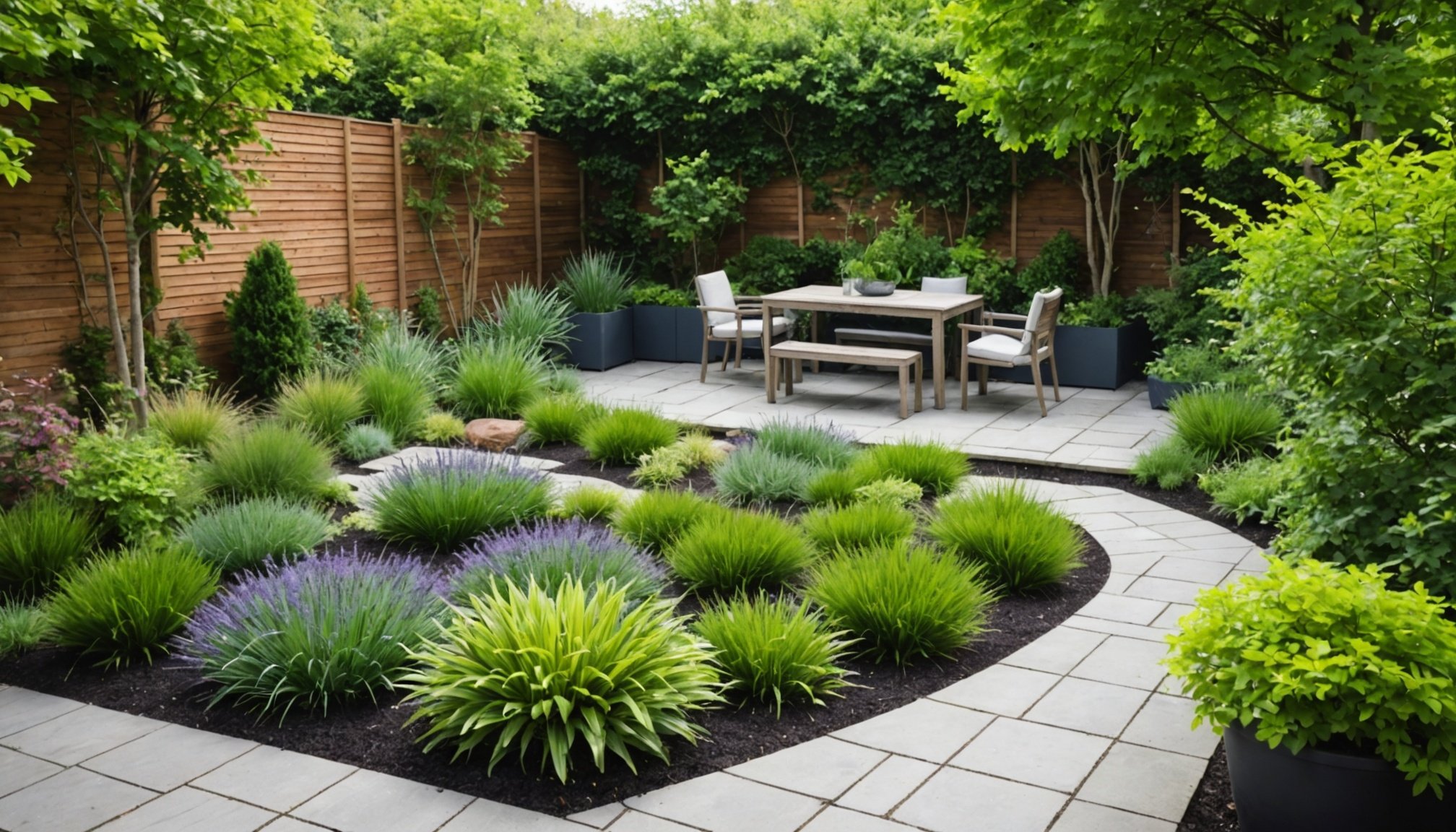Transform Your Urban Oasis: Creative Design Strategies for Multifunctional Outdoor Gardens in the UK
In the heart of the UK’s bustling cities, creating an urban oasis is not just a luxury, but a necessity for many. With increasingly smaller garden spaces, the challenge is to design an outdoor area that is not only beautiful but also functional and eco-friendly. Here’s how you can transform your urban garden into a vibrant and multifunctional space.
Embracing Vertical Gardening
Vertical gardening is one of the most innovative and practical trends for urban gardens in 2025. This technique allows you to maximize limited space by growing plants upward rather than outward, making it ideal for balconies, patios, and even indoor spaces[2][4].
Additional reading : Innovative space-saving solutions for compact bathrooms in the uk
Benefits of Vertical Gardening
- Space Efficiency: Vertical gardens use wall-mounted planters, trellises, or stacked pots to grow a variety of plants, saving valuable ground space.
- Aesthetic Appeal: These gardens add a lush, green layer to your walls, enhancing the visual appeal of your outdoor space.
- Improved Air Quality: By incorporating more plants, vertical gardens help purify the air and create a healthier environment.
- Year-Round Produce: You can grow herbs, vegetables, and fruits year-round, even in the smallest of spaces.
How to Create a Vertical Garden
To get started, follow these steps:
- Choose the Right Plants: Opt for plants that thrive in vertical environments, such as herbs like basil and mint, vegetables like indeterminate tomatoes and cucumbers, and fruits like strawberries and raspberries[2].
- Select Suitable Structures: Use tiered planters, trellises, arbors, wall-mounted pockets, or even repurposed materials like wooden pallets and rain gutters[2][4].
- Ensure Proper Support and Sunlight: Make sure your structure can support the weight of the plants and soil, and that the area receives adequate sunlight (6-8 hours a day) or use LED grow lights for indoor spaces[2].
- Maintain Your Garden: Regularly water, fertilize, and prune your plants to encourage healthy growth and prevent pests and diseases[2].
Focus on Wildlife-Friendly Gardens
Creating a wildlife-friendly garden is another trending idea for 2025. This approach not only enhances biodiversity but also adds a layer of natural beauty to your urban oasis.
Also read : Ultimate guide for uk homeowners: designing your landscape to withstand floods
Why Wildlife-Friendly Gardens Matter
- Biodiversity Support: By incorporating elements like bird feeders, hibernation boxes, and ponds, you support local ecosystems and encourage a variety of wildlife to visit your garden[1].
- Eco-Friendly: These gardens promote a natural balance, reducing the need for pesticides and other harmful chemicals.
- Visual Appeal: The presence of wildlife, such as birds and butterflies, adds a dynamic and engaging element to your garden.
How to Create a Wildlife-Friendly Garden
Here are some tips to get you started:
- Install Bird Feeders and Hibernation Boxes: These attract birds and other small animals, providing them with food and shelter[1].
- Create a Pond: Even a small pond can be a haven for aquatic life and attract a variety of birds and insects[1].
- Use Native Plants: Incorporate native plants that are attractive to local wildlife, such as flowers that provide nectar for bees and butterflies.
- Avoid Pesticides: Opt for natural methods to control pests, ensuring your garden remains a safe haven for wildlife.
Incorporating Forest Gardening Principles
Forest gardening, a technique that mimics a woodland ecosystem, is gaining popularity for its self-sustaining and low-maintenance benefits.
What is Forest Gardening?
Forest gardening involves layered, multi-storey planting to create a diverse and resilient ecosystem. This approach includes a canopy layer, an understory layer, a shrub layer, a herb layer, and a root layer, each contributing to the overall health and biodiversity of the garden[1].
How to Implement Forest Gardening in Your Urban Garden
Even with limited space, you can apply the principles of forest gardening:
- Use Compact Varieties: Opt for dwarf varieties of trees and smaller species that can thrive in smaller spaces[1].
- Layer Your Plants: Create a mini forest garden by layering different types of plants, from tall trees to ground-covering herbs.
- Utilize Containers: If you have a patio, you can still achieve a forest garden system using containers, ensuring there is enough space in the pot for the plants to reach maturity[1].
Designing Small but Impactful Urban Gardens
Small urban gardens require careful planning to maximize space and create a functional and beautiful outdoor living area.
Avoiding Dead Space
One of the key strategies in small garden design is to minimize dead space. Dead space is any area that cannot be used, such as the area under a table or around a BBQ. Here’s how to avoid it:
- Plan Carefully: Identify any potential dead spaces and plan your garden design to minimize them. For example, use the space under a table by incorporating a storage bench or a small herb garden[5].
- Use Vertical Elements: Incorporate tall but skinny plants or vertical gardening structures to make the most of your space without creating dead areas[5].
Creating an Oasis in the City
To create a garden that feels like an oasis in the city, you need to engage multiple senses:
- Sight: Use a limited color palette and focus on different greens, leaf shapes, and plant textures to create a cohesive look. Add movement with plants that sway in the breeze[5].
- Sound: Incorporate water features like small fountains or birdbaths to add soothing sounds to your garden.
- Smell: Plant scented flowers, herbs, and shrubs to fill your garden with pleasant aromas[5].
- Touch: Incorporate different textures through plants, stones, and other garden elements.
Modern Garden Design Elements
Modern garden design is all about creating a space that is both stylish and functional.
Topiary and Structured Gardens
For those who prefer a uniform look, topiary is set to be popular in 2025. Here’s how you can incorporate it into your design:
- Choose the Right Plants: Opt for plants that can be easily shaped and maintained, such as boxwood or yew.
- Create Geometric Shapes: Use topiary to create geometric shapes or even sculptures that add a touch of elegance to your garden[1].
Cottagecore Aesthetic
Cottagecore, a trend that combines the romantic and practical, is still on the rise. Here’s how to bring this aesthetic into your urban garden:
- Combine Flowers, Herbs, and Vegetables: Create a tapestry of color and texture by mixing different types of plants in your garden[1].
- Use Natural Materials: Incorporate natural stone walls, pavers, and cobblestones to add a rustic edge to your outdoor space[1].
Practical Tips for Urban Garden Design
Here are some practical tips to help you create a multifunctional and beautiful urban garden:
Table: Comparing Different Vertical Gardening Structures
| Structure | Description | Benefits |
|---|---|---|
| Tiered Planters | Stacked pots or planters placed on patios or balconies | Maximizes space, easy to maintain |
| Trellises and Arbors | Supports climbing plants like tomatoes, cucumbers, or beans | Adds vertical element, creates entryway |
| Wall Gardens | Planters or pockets mounted on walls to grow herbs, succulents, or flowers | Enhances aesthetics, improves air quality |
| Hanging Baskets | Baskets suspended from hooks or ceilings | Creates cascading effect, adds color |
| Pallet Gardens | Repurposed wooden pallets used as vertical planters | Rustic look, easy to set up |
| Gutter Gardens | Rain gutters attached to walls or fences to grow shallow-rooted plants | Space-efficient, unique look |
| Ladder Gardens | Old ladders used as vertical structures | Adds charm, functional |
| Wire Mesh or Fencing | Wire mesh attached to walls or fences to support climbing plants | Saves ground space, supports vertical growth |
| Vertical Hydroponics | Hydroponic system using vertical racks or towers | Efficient space usage, high yield |
List: Essential Elements for a Modern Urban Garden
- Water Features: Small fountains, birdbaths, or ponds to add soothing sounds and attract wildlife.
- Scented Plants: Incorporate plants with pleasant aromas to engage the sense of smell.
- Native Plants: Use plants native to your region to support local biodiversity and reduce maintenance.
- Vertical Gardening: Utilize vertical gardening techniques to maximize space.
- Natural Materials: Incorporate natural materials like stone, wood, and cobblestones to add a rustic touch.
- Lighting: Use outdoor lighting to extend the use of your garden into the evening.
- Seating Areas: Create comfortable seating areas to make your garden a relaxing retreat.
- Privacy Elements: Use tall plants or screens to create privacy in urban settings.
Transforming your urban garden into a multifunctional oasis is a rewarding project that can enhance your outdoor living experience. By incorporating vertical gardening, wildlife-friendly elements, forest gardening principles, and modern design elements, you can create a space that is not only beautiful but also eco-friendly and functional.
As Emma Fell from Hillier Garden Centres notes, “You can still incorporate the principles of forest gardening into your outdoor area, whether you have a few feet to work with or a sprawling acre. Opt for compact varieties and simply scale to suit the size of your outdoor area.”[1]
Whether you have a small patio or a larger garden, the key is to maximize your space creatively and thoughtfully. By following these strategies, you can turn your urban garden into a vibrant and inviting space that you will enjoy year-round.



